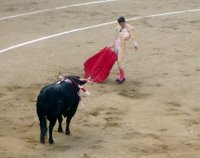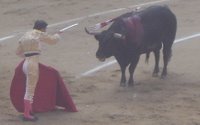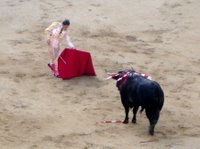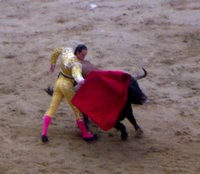





(Photos are self explanatory, no? I want only to point out that that horse you see is the one that gets shoved around by the bull. That coat he's wearing is his protection. Also, the photo of me and Daddy was taken before the bullfight, so we look quite happy. Actually, Daddy looks happy and I look horrid. But I like the expression on his face, so I thought it best to swallow my pride and post it anyway
: )
Daddy insisted that we go to a bullfight. And so we did. I can now say with authority that it is without question the most inhumane display of barbarism that I have ever witnessed and quite a putrid relic of gladiators days. In my view la corrida has no place in today’s world, or at least not a corrida with swords and killing. I’m quite sure that the “art” could be achieved and appreciated without the slow slaughter. Oh it was hideous.
There was a vociferous Spanish spectator next to us who, when the matador’s sword wouldn’t penetrate the bull’s body, bellowed with disgust, “No es así! Muy malo! Muy malo!!!” (not like that! Very bad! He muttered other things as well, but those were the only ones I could make out). He pitched the casings of his pumpkin seeds to the ground with gusto following each exclamation. Listening to him I was marked by the notion of there being a correct way to bleed a bull to death in this arena. Noticing my disgust, and taking advantage of daddy’s bathroom absence, he said, “oye, chica—it’s not “let’s go watch a bull die”, but art. This is art. And there’s a right way to do it.” (that was in Spanish, but I don’t know really exactly how to write what he said).
“De acuerdo,” I said carefully, “pero el torro va morrir, verdad? Entonces…” (okay, but the bull is going to die, right? So…) Before I could struggle through another sentence he had interrupted me and was repeating this business about it being art. I was unconvinced.
One very mildly positive thing I can point out is that I gained greater perspective on two commonly used expressions during the bullfight:
The matador spent many minutes doing a sort of tango with the bull and a crimson cape. Apparently, he was more or less hypnotizing the bull. In the end, the doomed creature charged into the swords that killed him because he ran toward the only thing he saw: the red. Hence the expression “seeing red.”
In the first part of the spectacle, before the matador is alone with the bull in the ring, a man enters, mounted on a sort of armored horse, with a long, thick javelin at his side (a thick round sword at the end). This horseman then stabs the bull from his perch. Subsequently the enraged bull charges at his attacker, jabbing his horns up into the underbelly of the (gagged and blindfolded) horse. The entire horse and rider are lifted up off the ground by bull’s head. And so I came to understand the meaning of “bull headed.” [PS this was a particularly horrific part of the bullfight. I couldn’t understand, though it was gagged, why the horse didn’t make any noise. I could see its hooves trembling in fear or pain, but it never made a noise. On the other hand, my pumpkin-seed gobbling, beer guzzling neighbor made lots of noise scoffing at my pity for the horse. He explained that before, until some years ago, the horse entered the arena unprotected. And so, in this way, it went without saying that part of the bullfight involved watching a horse get gored to death by the bull]
Also, watching the matador strut around the arena, chin tucked under, pelvis thrust forward arms spread back, recalled images of bullfighters from old Warner Brothers cartoons. The cartoonists were extremely accurate in their depictions of the facial expressions and movements which, to me as a child seemed absurdly, impossibly dramatic. And yet, no….
In all seriousness, I must say this:
I couldn’t have imagined I would have to blink away tears for the death of an animal
until I heard a 600 kilo bull bleating for mercy
as blood streamed from his mouth,
as the stadium cheered and applauded,
as the beaten animal finally collapsed,
twitching in a mass of wet, blackened sand.
This is what I carried with me out of the arena.
4 comments:
Oh wow....I wish you had vomited on the joker beside you! I would have never made it through the entire thing...as a surgeon, maybe it didn't bother your father.
Think I'll skip the bullfight in my lifetime after reading of your experience. I'm not exactly an "animal lover" but your description convinces me how barbaric this "artistic" pastime really is.
oh no! Daddy thought it was awful. He was literally speechless. From time to time he shook his head and looked away. As we walked out of the arena, he said "That was the worst thing I've ever seen. I've seen a lamb slaughtered to be eaten, but they don't torture it. It isn't like this. The bull was crying. Would people say this was a beautiful thing if this happened in a Muslim country?" I thought it was a very interesting thought--what things does the "West" allow itself but reproaches of others?
It would be a very interesting thought too if you stop and think how many bulls live in your countries...
"El Toreo" is an art, for sure, but it's even more than that. It's like a challenge between the man and the animal.
You have to know that the bulls live 4 or 5 years before they die in the bullring. Until that day, thet are the best of their owners's houses. They are their pride. Many livestock farmers really love their bulls, fuss over them, and fell pain for giving them to death. But it's their destiny. Their lifes are written from the moment where they are born.
We eat chickens (or fishes, or lambs, never mind) that were born to be killed and eaten by people like me and you. Not only killed, even eaten. And I'm sure that no one of you cry for it.
Sometimes, unusually, if the bull has involved bravely, its life is forgiven and die in the country, free...
I understand that the spectacle is quite grotesque if you don't know the meaning of the different things which take place in it. I advise to read before write, and try to understand some basic things about our main tradition.
Post a Comment